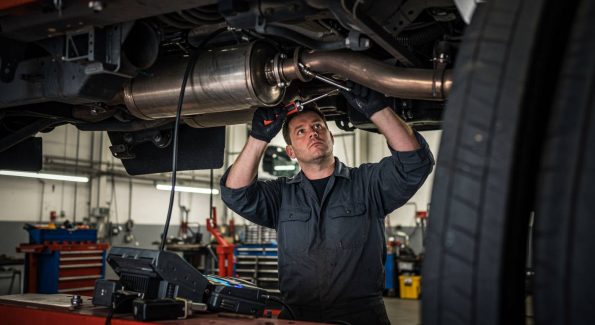Recognising Potential Hazards

Unexpected road conditions emerge from multiple sources, including meteorological events, infrastructure maintenance, and environmental factors. Heavy rainfall reduces visibility and compromises traction, while fog significantly impairs visual acuity and distance perception. Strong crosswinds pose challenges for high-sided vehicles, affecting stability and directional control.
Road construction necessitates navigational adjustments and heightened awareness, while debris ranging from fallen vegetation to discarded materials creates immediate obstacles. Wildlife activity, particularly during dawn and dusk, represents another significant hazard on Australian roads.
Hazard recognition requires continuous assessment of the driving environment. This includes monitoring the road surface for changes in texture or reflectivity that might indicate wetness, ice, or loose material. Additionally, observing the behaviour of surrounding vehicles can provide early indication of potential hazards ahead. Proper hazard perception forms the foundation of effective response strategies.
Preparatory Measures for Safe Driving
Preparation constitutes a critical component of safe driving practice. Checking weather forecasts and traffic reports before commencing journeys allows for route adjustments or timing modifications to avoid severe conditions. Vehicle maintenance plays an equally important role in preparedness, with regular inspections of tyres, brakes, windscreen wipers, and lights ensuring optimal functionality when unexpected conditions arise.

An emergency kit containing essential items such as a first-aid kit, high-visibility vest, torch, warning triangles, and basic tools should be carried in every vehicle. Additionally, maintaining sufficient fuel levels prevents becoming stranded in adverse conditions. Mobile phones should be fully charged with relevant emergency service numbers readily accessible.
Adaptive Driving Techniques
Speed Management
Speed adjustment represents one of the most effective responses to changing road conditions. Reduced speed provides additional time for hazard assessment and response implementation and (if time isn’t a factor), will usually provide improved fuel economy due to the reduced effects of rolling resistance and wind resistance. On wet surfaces, following distances should be doubled; speed reductions are appropriate in heavy rain, fog, or when encountering loose surface materials. The fundamental principle remains that speed should allow complete vehicle control and stopping within the visible road distance ahead.
Distance Control
Proper following distance adaptation is essential when navigating unexpected road conditions. While the standard three-second gap provides adequate reaction time in optimal conditions, this interval should be extended to five or six seconds or more during adverse weather or when visibility is compromised. This expanded buffer accommodates increased stopping distances on wet or slippery surfaces and compensates for reduced visual information in fog or heavy rain.
Visual Techniques
Effective visual scanning techniques significantly enhance hazard detection. The practice of looking well ahead (10-15 seconds of travel distance) allows early identification of potential issues, while maintaining awareness of peripheral movements detects emerging hazards from roadsides. Continuous scanning between distant, middle, and near visual fields ensures comprehensive awareness of the driving environment and potential condition changes.
Managing Specific Road Challenges
Wet and Slippery Surfaces

Wet road surfaces require specific handling techniques to maintain vehicle control. Smooth, progressive inputs to steering, acceleration, and braking prevent traction loss, while avoiding standing water reduces hydroplaning risks. If aquaplaning occurs, maintaining a straight steering position and gradually reducing speed (without braking sharply) allows tyres to regain contact with the road surface.
Driving through long puddles that sit in the depressions in the road caused by thousands of vehicles passing over them impacts your fuel economy because of the increased rolling resistance – your wheels have to push through that water. If you can move slightly off-track, you’ll see an improvement in fuel economy, but take care that you are then not too close to the edge, or straddling the centre line.
Oil slicks, particularly prevalent after initial rainfall following dry periods, create exceptionally slippery conditions. These hazards appear as rainbow-coloured sheens on road surfaces and require significantly reduced speed and increased following distance when encountered.
Limited Visibility Environments

Fog, heavy rain, and dust storms drastically reduce visual information available to drivers. In these conditions, appropriate light usage becomes critical—low beam headlights improve vehicle visibility to others without creating counterproductive glare. Fog lights, when fitted, should be utilised in accordance with their intended purpose for severe visibility reduction.
Maintaining clear windows through proper use of demisting systems and ensuring clean windscreens, both inside and out, maximises available visibility. Speed reduction should be proportional to visibility loss, with extreme conditions potentially necessitating temporary stoppage in safe locations well clear of traffic lanes.
Road Surface Irregularities
Potholes, uneven surfaces, and loose materials require vigilant monitoring and appropriate response strategies. When encountering such hazards, controlled straight-line braking before reaching the hazard, followed by releasing the brakes while traversing the irregular surface, provides optimal vehicle stability. Where safe to do so, steering to avoid severe potholes prevents vehicle damage and potential control loss.
Construction zones present multiple hazards, including changed traffic arrangements, uneven surfaces, and loose materials. Strict adherence to posted speed limits and traffic management directions is essential in these areas, as is maintaining heightened awareness of construction vehicles and personnel.
Emergency Response Procedures
Vehicle Control in Critical Situations

Despite preventative measures, critical situations requiring emergency response may still arise. Understanding correct recovery techniques for skids remains vital—steering into the direction of a skid (toward where the vehicle needs to go) while avoiding harsh braking allows for control recovery. For modern vehicles with electronic stability control, maintaining steady pressure on the brake pedal while steering in the intended direction allows the system to optimise traction.
Sudden tyre deflation requires a firm grip on the steering wheel to counteract pulling forces, with gradual speed reduction through controlled braking. Avoidance of sharp steering inputs prevents vehicle destabilisation during this process.
Safe Stopping Procedures
When immediate stopping becomes necessary due to hazards or mechanical issues, implementing proper procedures minimises secondary risks. Activating hazard warning lights alerts other road users to the developing situation. Where possible, vehicles should be manoeuvred to road shoulders or emergency stopping lanes before coming to a complete stop. Once stationary, appropriate warning devices such as triangles should be deployed at suitable distances behind the vehicle to provide advance warning to approaching traffic.
Technological Assistance Systems
Modern vehicles incorporate multiple systems designed to assist with unexpected road conditions. Anti-lock braking systems prevent wheel lock during heavy braking, maintaining steering capability on slippery surfaces. Electronic stability control detects and corrects skidding tendencies through selective wheel braking and engine power modulation. Traction control systems optimise acceleration on low-friction surfaces by preventing wheel spin. Trailers with trailer EBS will use all their electronic trickery to avoid the trailer swinging out or jackknifing the prime mover.
While these systems significantly enhance safety, understanding their limitations remains important. Technology supplements rather than replaces proper driving techniques, and overreliance can lead to inappropriate confidence in severe conditions.
Conclusion
Professional management of unexpected road conditions encompasses thorough preparation, continuous hazard assessment, and implementation of appropriate driving adjustments. By developing and applying these skills, Australian drivers contribute significantly to overall road safety. The dynamic nature of road conditions demands adaptive driving approaches based on sound principles and techniques.
Road safety represents a collective responsibility requiring individual application of professional driving standards. Through consistent implementation of the strategies outlined in this guide, navigation of unexpected road conditions becomes a manageable aspect of the driving task rather than a source of elevated risk. This approach ensures optimal safety outcomes across Australian roads regardless of changing conditions or unforeseen circumstances.
